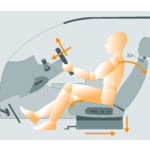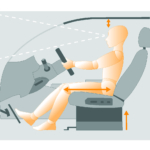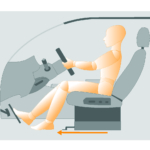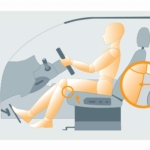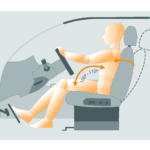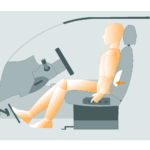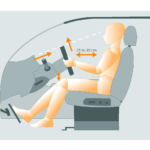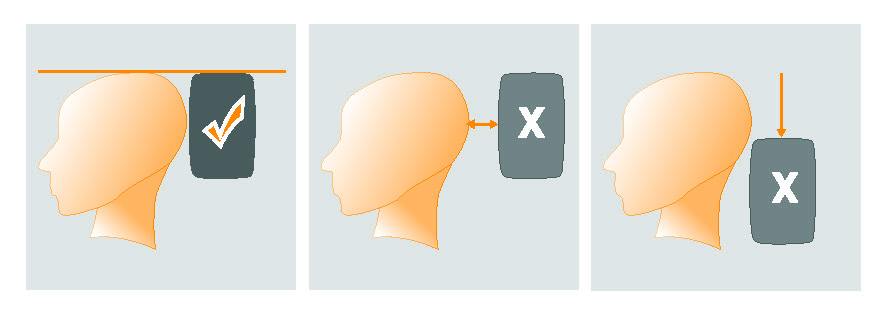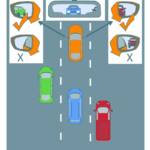
Tool Kit
Driving for Work
Driving for work can be dangerous. Crashes cause the most work-related traumatic deaths in BC. But nearly all of them can be prevented. Find out how the right knowledge, attitude, vehicle adjustments and driving skills can help you stay safe.
Preparing yourself
Knowledge, skills, and attitude are important for safe driving. Preparing yourself before you drive can reduce your crash risk and lessen driving stress and fatigue.
Build knowledge and skills
No matter how much you drive or how long you’ve been a driver, you’re at risk on the road. But knowing and living up to your safety responsibilities can reduce that risk. Legally, you need to take steps to keep yourself, your co-workers and others safe. This applies whether you use your own vehicle or your employer’s.
You also need to build your skills and knowledge. If you’re not confident in your driving abilities ask your supervisor for training and coaching. Ask for additional learning resources. Talk with other drivers who have more experience. Practice what you learn.
Use practice tests to build and maintain your knowledge of road signs, driving behaviours, and the rules of the road. Take ICBC’s driving knowledge practice test and apply what you learn to improve your skills.
Know and follow the rules of the road and your organization’s safe driving policies and procedures.
Develop a safety attitude
Your attitude matters when it comes to being prepared. Crashes aren’t always the fault of the other driver. Be focused, courteous, patient, and respectful when you drive.
Be sure to carry over the positive driving attitude you develop and apply at work to your personal driving. Just as you’re responsible for the safety of your co-workers, you’re equally responsible for the safety of your family and friends.
Getting ready to go
Preparing to drive starts before you put the keys in the ignition. Follow these steps to prepare for a safe trip.
Even short or occasional drives can be dangerous – especially when weather or road conditions are bad. Can you use email, virtual meetings, phone calls, or other tools to avoid travelling to in-person meetings? You’ll save time and money, and remove the risks of driving.
If you must be at the job site, meeting, or client location, you might consider an alternative to driving. Public transit, ride-sharing, taking a taxi or flying are all less risky than driving.
Use our Journey Management and Trip Planning Tool Kit to help build low-risk trip plans.
Using the right tool for the job is a basic rule for safety. Make sure the vehicle you’ll be driving is fit for the job. How long ago was it serviced? Is it equipped with proper tires and are they in good condition? Are all the lights working and are the wiper blades in good shape? These are the kinds of questions you need to ask before agreeing to take a company vehicle on a long – or short – journey. You’ll need to complete a pre-trip vehicle inspection.
If you’re using your personal vehicle, you should know the answers to these questions. But is it the right kind of vehicle for the driving you need to do?
High heels and work boots were not designed for driving. Choose shoes that fit you well, are comfortable, and give you a good grip on the pedals. You could have 1 pair for driving and another for your destination. Avoid clothes that might get in your way and slow your reaction time – tight pants and skirts, bulky jackets, mittens, and scarves, for example.
- Keep essentials like water and sunglasses within easy reach. Reaching or fumbling for items while you’re driving is distracting and dangerous.
- Secure loose items that could roll or slide under your feet or the pedals, or become dangerous projectiles in a crash.
- Remove all items from the dash and put them in the console or glove box.
- Make sure heavy objects and cargo are secured in the trunk or back of the vehicle.
If there’s a big step up or down:
- Don’t “jump” into or out of the vehicle.
- Use three points of contact.
- Use the handle or grab-strap.
- Consider installing a step or running boards to reduce step height.
If you’re a truck driver, watch WorkSafeBC’s video on driver ergonomics.
If you have limited mobility, it might be easier to get in the vehicle by sitting in the seat and then swinging both feet in. To get out, face forward in the seat and swing both feet out and onto the ground.
Preparing your vehicle
Once you are prepared for the drive, ensure your vehicle is also ready. Adjust your seat, mirrors, head restraint, and seat belt to improve your safety and comfort. Hold your steering wheel and place your feet correctly. Making your vehicle comfortable to drive reduces stress and fatigue. It can also help you avoid injuries like back and wrist strain.
Adjust your seat
When you’re driving, you should be comfortable and able to reach the pedals, steering wheel, levers, and knobs easily.
Aim for a seating position that puts the largest amount of your body in contact with the seat. Sit in the seat, not on it. Push your lower back into the seat and sit tall to stay alert and see clearly.
Follow these instructions to adjust the seat in any vehicle you drive for work. Click the images to enlarge them.
Adjust foot position
Plant your left foot against the footrest area to the left of the brake or clutch pedal. This will brace your entire body.
This lets you work the pedals with greater accuracy and control. It also means you aren’t relying on the steering wheel for support during hard braking. This improves your ability to operate the steering wheel quickly and accurately.
Keep your right heel on the floor so you can turn your foot at the ankle to operate the pedals. Lifting your foot off the floor to apply the brakes is less effective.
Adjust head restraints
Head restraints aren’t headrests. They should support the back of your head and neck, and protect you from severe neck injuries if you’re rear-ended.
The top of the head restraint should be level with the top of your head and less than 10 cm from the back of your head. Leave enough room to turn your head without touching the restraint.
Adjust the seat to a slightly more upright position to move your head closer to the restraint.
Click image to enlarge.
Check the passenger head restraints, and adjust both the front and rear seats
Adjust mirrors
Mirrors should give you the fullest possible view with the least amount of extra effort. In a quick glance, you should be able to see vehicles beside and behind yours.
Click image to enlarge.
Here’s how to set your mirrors:
- Rear view: Adjust it to give you a view straight out the back window while you’re sitting in the normal driving position. Don’t tilt it to help you see traffic on either side of your vehicle. That’s what the side mirrors do.
- Driver side: Adjust it outwards so it’s just past the point at which you can see the left rear corner of your vehicle. You should not be able to see the side of your vehicle until you tilt your head to almost touch the driver’s side window.
- Passenger side: Adjust it outwards so it’s just past the point at which you can see the right side of your vehicle. If you tilt your head towards the centre of the vehicle, you should be able to just see the right side of your vehicle.
At first, this wider-angle view from your side mirrors may seem strange. But widening your view minimizes blind spots. Have someone stand in the blind spots while you adjust your mirrors to test it. You can also try a gradual approach, adjusting the mirrors outward a little more each day.
Set the side mirrors properly so that vehicles behind you can’t shine their lights in your eyes. To further reduce glare, flip up the lever on the bottom of the rear-view mirror.
When you’re used to the new mirror settings, you’ll be able to see more and drive with more confidence.
Adjust seatbelts
A properly adjusted seatbelt is the best protection against injury in a crash. Even an extra centimetre of slack can make the difference between serious or minor injuries.
When you’re sitting passively, a correctly adjusted belt allows a bit of movement. On impact, the belt sensors lock it in place. If you find the shoulder strap uncomfortable, use shoulder strap covers or cushions.
Follow these tips for seatbelt safety:
- Keep the lap belt snug and as low on your hips as possible.
- Ensure the shoulder belt comes across your shoulder without cutting across your neck. In most vehicles, you can adjust the belt for proper placement and comfort.
- Make the shoulder belt snug across your chest. If the belt has any slack, your body will gain momentum in a crash before hitting the belt, increasing the risk of injury.
- Never wear the shoulder belt under your arm. It greatly increases risk of injury in a crash.
Adjust the interior
Maintaining a comfortable temperature and good visibility can reduce your risk of crashing.
The optimal temperature for driving comfort is about 18°C. Above 20°C is a little too warm because you can become drowsy. Some drivers keep the window open a crack or set the fan on low to keep the air fresh.
Dust that collects on the inside of your windows can affect visibility, especially when driving towards the sun. Dirty windows may also force you to crane your neck or get into an uncomfortable position to see. Clean the inside of your vehicle’s windows at least once a month.
Keeping comfortable and safe on the road
After you prepare yourself and your vehicle for the drive, follow these tips to optimize comfort, minimize stress and maximize safety.
How you grip the wheel influences how well you can control the vehicle. A proper grip also reduces the risk you’ll be injured if the airbag deploys during a crash. The grips recommended most often are:
- Left hand at 10 o’clock position and right hand at 2 o’clock.
- Left hand at 9 o’clock and right hand at 3 o’clock.
Adjust and vary your grip to maintain circulation and avoid fatigue in your hands, wrists, and arms. If your knuckles are white, you’re gripping too hard.
Grasp the steering wheel with both hands and wrists straight, your elbows slightly bent, and your shoulders neutral (arms by your sides).
Practice safe driving when you’re on the road:
- Follow the rules of the road and your organization’s safe driving policies and procedures. Don’t speed, for example. It’s the leading cause of crashes.
- Leave the phone alone. Better yet, put it in the glove box or the trunk. Distracted driving leads to a lot of crashes in BC.
- Drive according to the weather and road conditions.
Remember that you have the right to refuse driving that you believe is unsafe.
Vary your seating position to ease tension. Shift your weight and adjust your posture to keep comfortable.
Do some stretches while you’re stopped at a traffic light. Tighten and relax your feet, ankles, thighs, core, shoulders, arms, and neck muscles when it’s safe to do so. Extend your legs, reach behind the seat and stretch your shoulders, and roll your neck a few times.
Learn more about driving and ergonomics.
Pull over in a safe place to get out, walk around, stretch, check tires, use the washroom, and use your phone. It only takes a few minutes and can help to prevent neck, back, and shoulder discomfort.
Drink water and eat a healthy snack. Avoid sugary or caffeinated beverages and choose high-protein snacks over fatty foods like fries.
If you can, alternate between long drives and short trips. This helps you manage boredom and fatigue.
